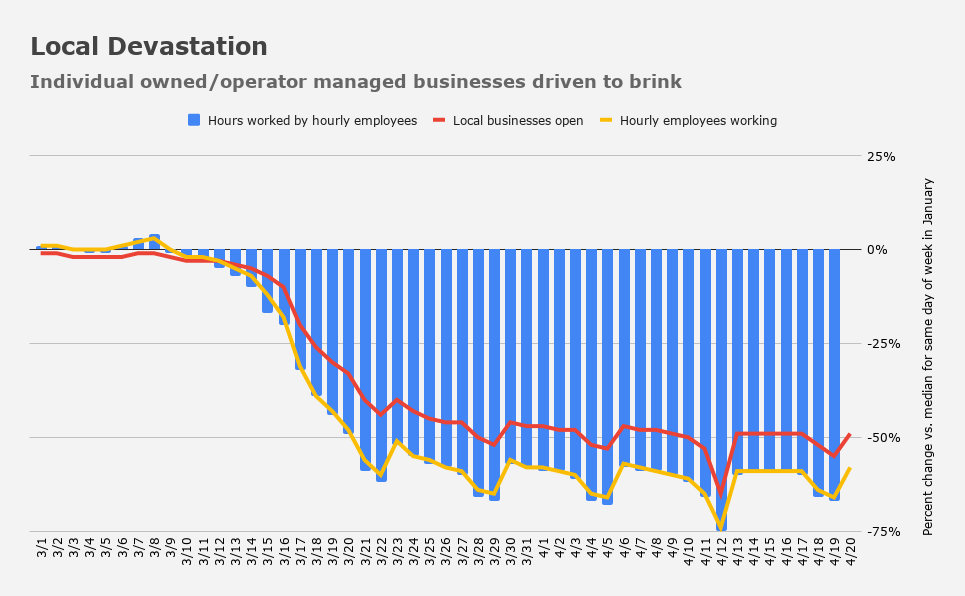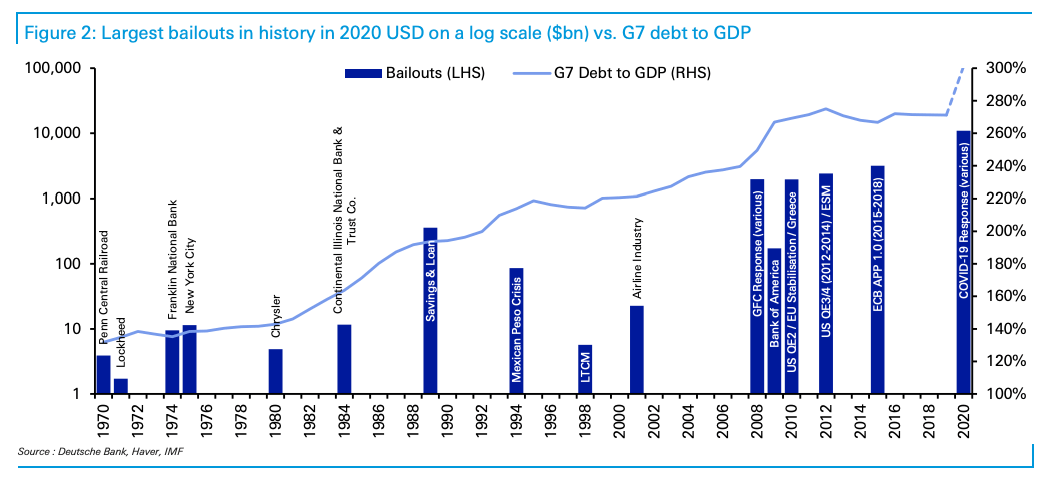It looks like you're new here. If you want to get involved, click one of these buttons!
https://bloomberg.com/news/articles/2020-04-27/boj-ramps-up-stimulus-with-pledge-for-unlimited-bond-buyingThe Bank of Japan.....promised to buy as many government bonds as needed and more than doubled its buying of corporate debt, as Governor Haruhiko Kuroda tried to show the BOJ was pulling its weight in national efforts to support struggling factory owners, shopkeepers and consumers.
“If you look at what we’re doing from the size of our balance sheet against GDP to our measures compared to the size of the commercial paper and corporate bond markets, the scale of the Bank of Japan’s easing is far larger than any other central bank,” Kuroda said at the briefing.
...the BOJ can now make unlimited purchases at a time when record public spending will require new bond issuance to pay for it.
“Impressions matter in this kind of crisis. While the BOJ’s balance sheet is, of course, much bigger than its peers, the response to this kind of crisis is very important.” said Masamichi Adachi, chief Japan economist at UBS Securities and a former BOJ official.
For a few months, I've been promising myself to make a post on being careful about what numbers do and don't represent (i.e. look behind the numbers). Figures like ERs, duration, performance. One of these days.I own PRIDX. ... It fell hard with coronavirus. But it's coming back, down -13% now, ytd. Down to 3 stars, but still with a silver decoration. ... Top 15% among peers, ytd. Not a great showing compared to peers LAST year, but still very good indeed.
The manufacturing sector hasn't completely rolled over yet, but the services sector simply ceased to exist starting late last month.....The message is clear: Main Street isn't just hurting, it is disappearing in a very literal sense. As Atlanta Fed boss Raphael Bostic warned earlier this month, "May is going to loom large, in terms of the transition of concern from this being a liquidity issue… to this perhaps translating and transferring into a solvency issue, and whether companies can exist at all."

.(...from Homebase, a scheduling and time tracking tool used by more than 100,000 local businesses covering 1 million hourly employees.)
Deutsche Bank rolled up the fiscal and monetary support programs announced and implemented in the US and Europe into a single "bailout" figure. The sheer size of the COVID-19 response necessitated a log scale (on the left axis) in order to help "better identify the earlier bailouts and get a rough feel visually for the numbers," as the bank put it. ....."Obviously we won’t know how much will be used until much further down the road," the bank cautioned, in the course of presenting the numbers and accompanying visuals.

https://seekingalpha.com/article/4340027-dystopia-now
....policymakers have been deliberately suppressing volatility, compressing risk premia, tamping down credit spreads and keeping the market wide-open for borrowers for the better part of a decade....
Deutsche Bank's George Saravelos.....At the extreme, central banks could become permanent command economy agents administering equity and credit prices, aggressively subduing financial shocks. With unlimited capacity to print money, central banks have unlimited capacity to intervene in asset markets too. Put simply, a central bank that pegs bond, credit and equity markets is highly likely to stabilize portfolio flows as well.
The Trinity Study:First, I wanted to see how this was working with recent stock market returns. The original study was only covering years up to 1995. I wanted to have more recent data. I wanted to make sure that the results were holding with more recent stock market behavior. So this simulation will cover returns until the end of 2019!
Secondly, the original study was only covering up to thirty years of retirement. I wanted to be sure that the portfolio can sustain withdrawals for much more extended periods. For people retiring early, I think that 50 years is not unreasonable.
You don't have to invest in a high yield bond fund for your mission."And we should not have to invest in JUNK in order to get a decent income stream, each month..."
https://www.marottaonmoney.com/if-you-act-fast-you-can-undo-your-2020-rmd-thanks-to-the-cares-act/Furthermore, although qualified charitable distributions (QCDs) can be used to satisfy your RMD, I believe that you cannot make a rollover contribution using those funds. To be a qualified charitable distribution, the assets need to be paid directly to the charity. However, in order to begin a rollover contribution, the funds must be paid directly to you so they are under your control. Thus, even though I cannot find an explicit ruling on the matter, I believe any QCD already taken in 2020 will also be final.
blog.yardeni.com/2020/04/fed-trying-to-contain-zombie-apocalypse.htmlCreating the Zombie Apocalypse. Fed Chair Jerome Powell is doing an admirable job of playing the action hero in “2012 Zombie Apocalypse,” a 2011 film about a fictional virus, VM2, that causes a global pandemic. He is doing whatever it takes to stop the zombies from killing us by ruining our economy and way of life.
A couple of tweaks.YOU have 60 days to return it from date of distribution, I believe I read. Although that may be from CARES implementation.
(Already taken out your 2020 RMD but wish you hadn’t? You might be able to roll over distributions you’ve already taken for 2020, says Slott. If you've already received a distribution from your own IRA or one inherited from a spouse for 2020, you can roll it back into your IRA within 60 days of receipt. ]
(Nerd Note: The lone exception for beneficiaries would be for a spouse who chose to remain a beneficiary of the deceased spouse’s retirement account. In such an instance, they may be eligible to put the RMD back into their own retirement account, as a spousal rollover, using one of the methods described above.)
© 2015 Mutual Fund Observer. All rights reserved.
© 2015 Mutual Fund Observer. All rights reserved. Powered by Vanilla